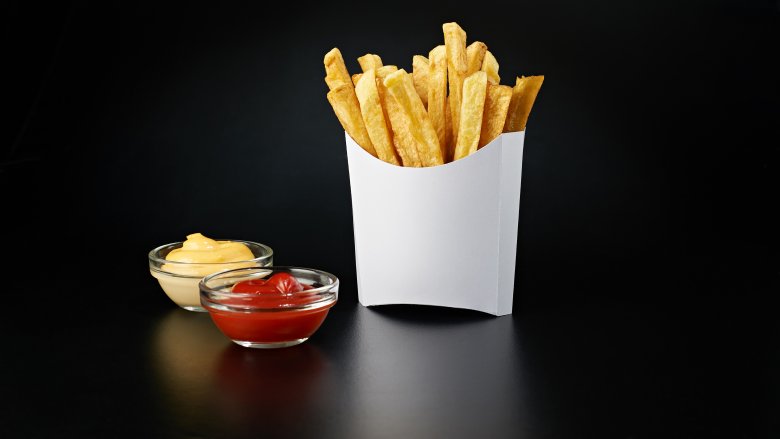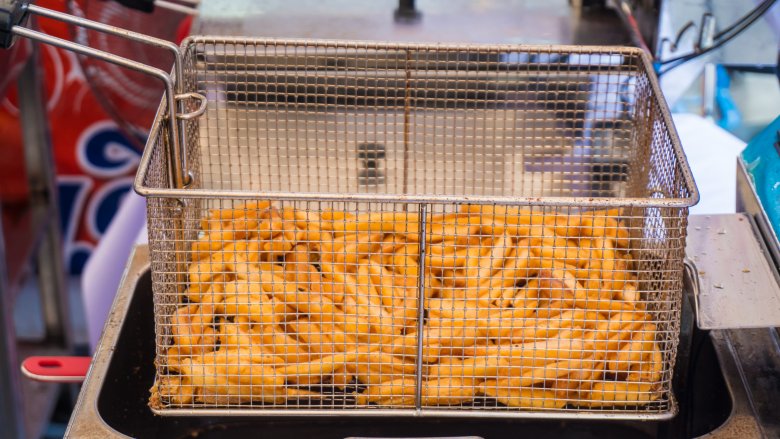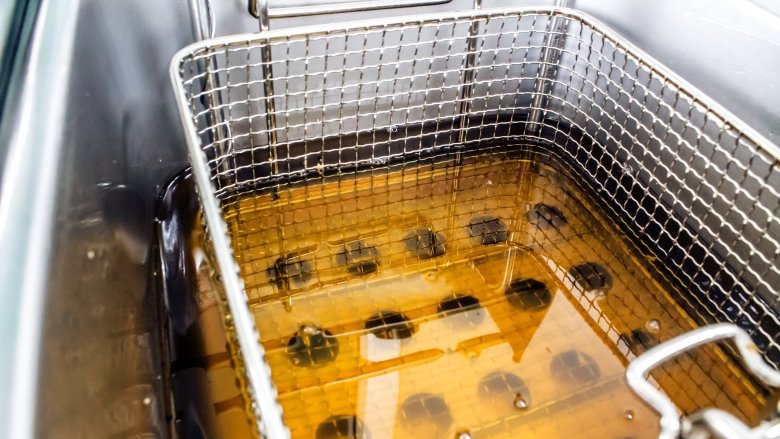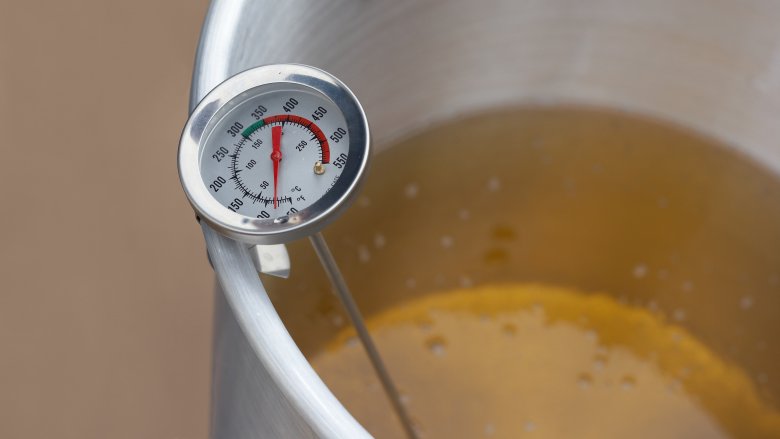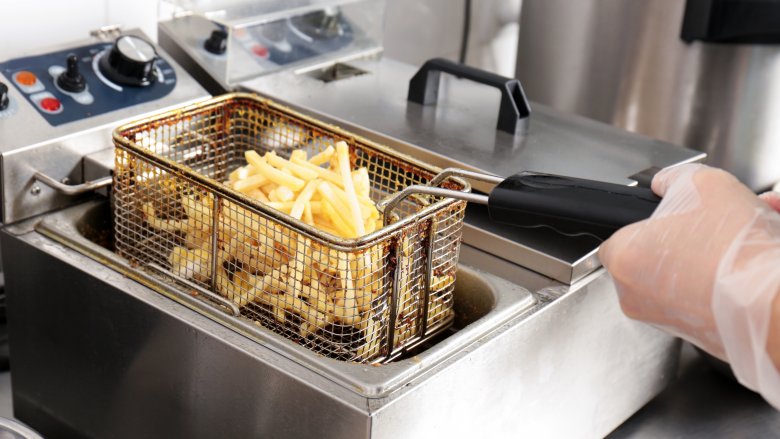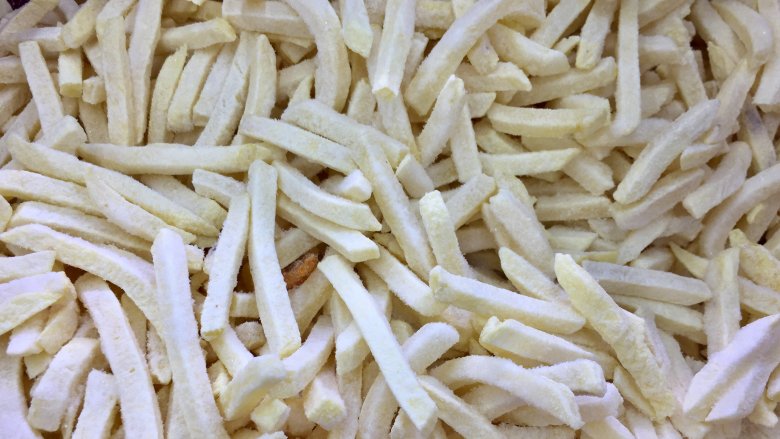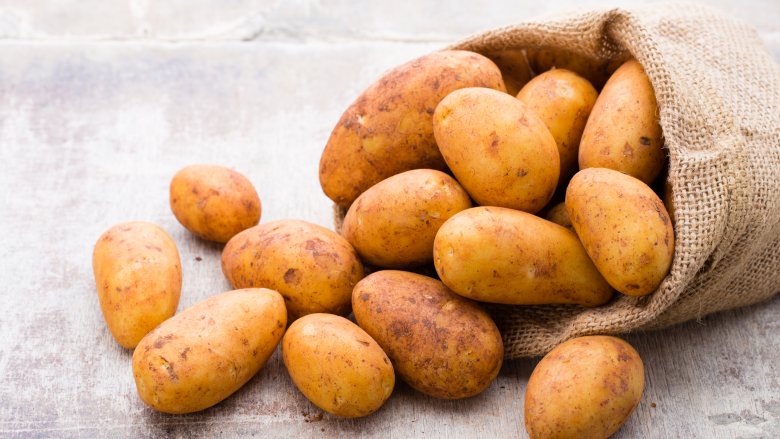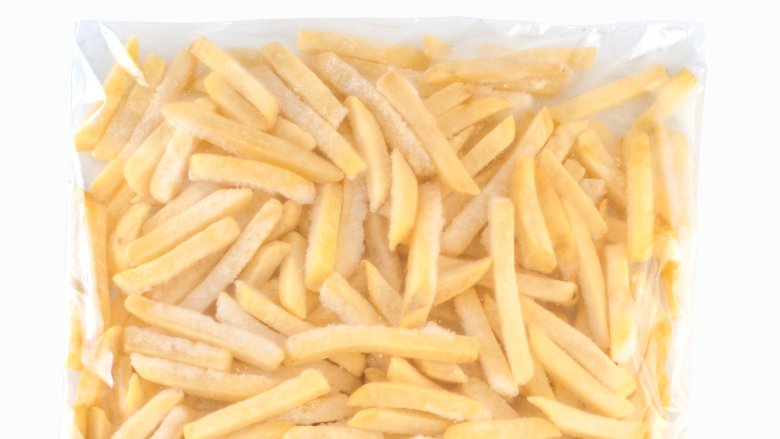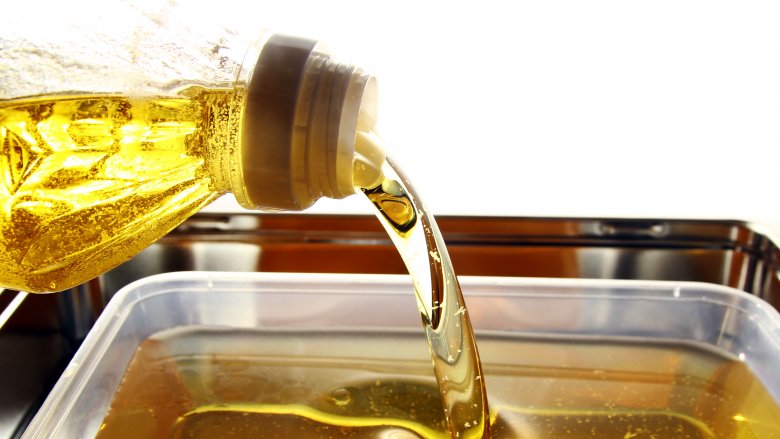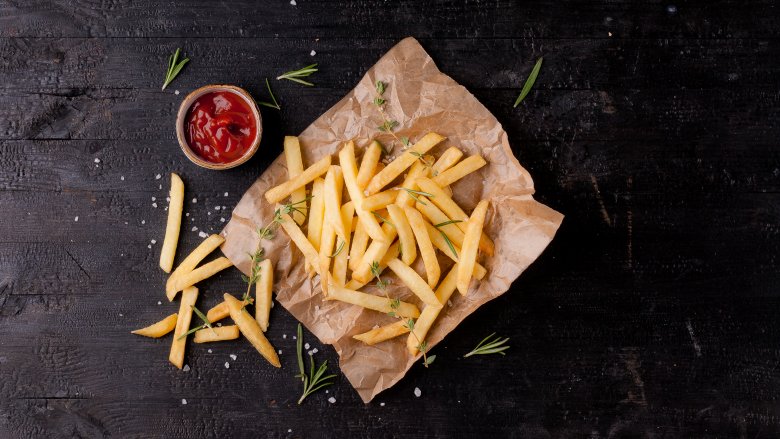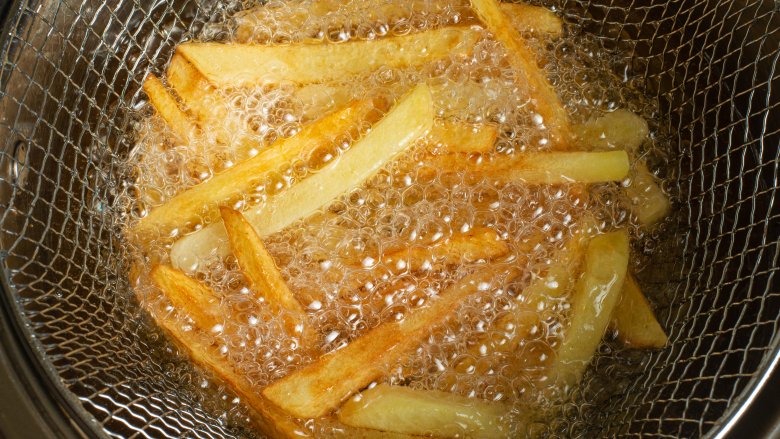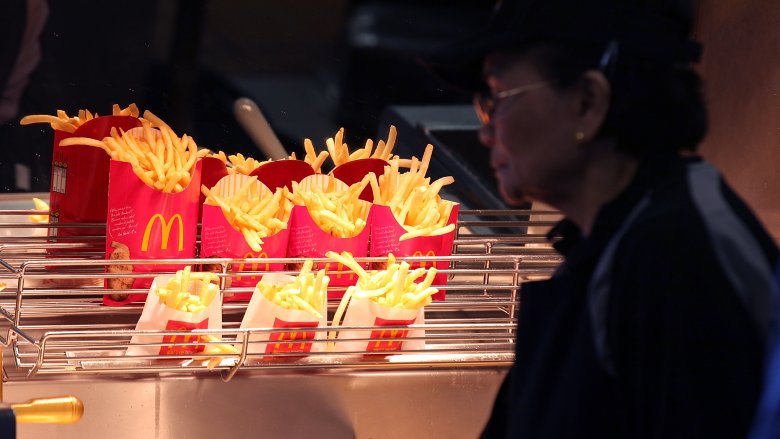How Fast Food Restaurants Really Make Their French Fries Crispy
How hard could it be to turn potatoes into french fries? You just have to slice potatoes into little strips and toss them in hot oil, right? Wrong. If you've ever tried making french fries at home, you know they don't always turn out as crispy and delicious as the ones you get at your favorite fast food restaurant. Those guys make it look easy — creating fries that are crispy on the outside but soft and pillowy on the inside — because they have a few tricks up their sleeves. Use the wrong potato, and the fries will turn out chewy. Choose an ill-suited fryer oil, and the potatoes can taste terrible. Fry at too-cold temperatures and they'll be soggy (but don't get too hot, or they'll burn before they cook through).
Who knew that this much effort went into making a value-priced side dish! There are a lot of rules for making crispy french fries, and while most of our favorite restaurants are getting it right, some fast food fries still don't end up as crispy as McDonald's (the gold standard in french fries). Read on to learn the things that the best fast food restaurants are doing to make the perfect french fry.
They use the right equipment to make french fries
If you want to fry potatoes to crispy perfection, you need to start with the right deep fryer. Sure, you can use a wok or a Dutch oven to fry at home, but a deep fryer is an appliance specifically designed to heat oil to a precise set of temperatures. There are table-top versions aimed at home cooks, but commercial fryers are in a league of their own, and the pros argue that they make better fries. They're designed for heavy-duty use, holding the fryer oil at exact temperatures for hours on end. Many of them are hooked up directly to a gas line, too. That allows restaurants to recover temperatures faster than you can at home with an electric heat source.
The other important thing these commercial appliances allow you to do is to reuse fryer oil very efficiently. They have lids or covers that protect the integrity of the oil as it sits overnight, along with heavy-duty filters that can remove impurities from the oil after use. The purpose of reusing the oil isn't just to save money, either. There's a lot more to it than that.
Aged oil actually produces crispier french fries than new oil
The filters on commercial deep fryers allow you to use the oil more than once, which isn't just a money-saving tactic. It turns out that aged oil actually makes the fries crispier than new oil. According to The Spruce Eats, fresh oil straight out of the bottle isn't the best choice when frying up a batch of french fries. You see, the fats in the oil start to break down as it's exposed to heat. That might sound bad, but it's a huge plus when it comes to making crispy french fries: The oil molecules in this aged oil will bond more effectively with the food, resulting in a crispier product.
That doesn't mean all aged oil works. When the oil gets too old, it can start to smoke at higher heats, which creates an off-flavor for your french fries. It's also important to filter the oil really well to remove any food bits or impurities that can burn the next time the oil is heated. Epicurious also reminds us that used oil hangs onto the flavors of whatever it originally fried. Reusing oil that you used to fry onion rings wouldn't be a problem for making french fries, but oil used for making fried fish will make your fries taste...well, a little fishy.
They fry french fries at the right temperatures
Deep frying is more of a science than an art; you can't just toss potatoes into hot oil all willy-nilly. The specific temperature of the frying oil matters — a lot. Fine Cooking explains that deep frying works because the hot oil dehydrates the surface of the food, creating a crust. That process not only causes the outside to brown and crisp up, but it also prevents the food from absorbing too much fat-filled oil. It basically forms a protective barrier, but it only works at the correct temperature range. Drop below the range, and the crust will form too slowly, allowing the oil to soak into the food. That can create a soggy, oily french fry instead of a perfectly crispy one. On the other hand, frying at excessively hot temperatures can burn the outside of the potato before the inside cooks through.
Fast food restaurants know that the range of 325 to 400 degrees Fahrenheit is perfect for fried foods. The exterior crust forms quickly at these temperatures and crisps up to a gorgeous, golden-brown color. At the same time, the inside becomes soft and fluffy. All this doesn't mean that you have to fry at one temperature, though; some of the best fast food restaurants use a double-fry process.
It's all about the double-fried potatoes for crispy french fries
Fast food restaurants know the true secret to making the crispiest french fries: Fry them not once, but twice. The Kitchn reveals the secret that Burger King, Five Guys, and Wendy's uses to make their fries crispy on the outside but pillowy and soft on the inside. They start by frying the cut potatoes at around 375 degrees Fahrenheit for about a minute. When the potato starts to turn a light golden brown, they remove the fries from the heat and let them cool for 10 to 15 minutes. This first round in the fryer par-cooks the potato, starting to cook the insides of the french fry while simultaneously building a protective crust on the outside.
Once the potato is cooled, they fry it a second time — also at around 375 degrees, although some restaurants use temperatures as high as 400 degrees — until the fry is crispy and golden brown. This second frying session takes longer (about four to five minutes), but it results in the perfect balance between textures: soft but crispy.
The french fries are often dried or frozen to achieve the perfect levels of starchiness
This isn't true of all the big chains — Five Guys hand-cuts french fries in house — but most fast food places receive pre-cut potatoes that are dehydrated or frozen first. There's a pretty good reason for this: Consistency. New potatoes (or potatoes that are harvested early in the season) are full of sugars. As the potato ages, those sugars convert to starches. What does that mean for french fries? Potatoes will fry up differently during different times of the year, so drying and freezing them ensures they maintain the perfect level of starchiness.
In a video made by Swizzle, we had the opportunity to follow McDonald's french fries through the entire process, from harvesting the potatoes, to cooking the crispy french fries. They do indeed start as real potatoes, not little tubes injected with potato goo. After they're cut through a precision-cutting water knife, the potatoes are dipped in dextrose and sodium acid pyrophosphate to give them a consistent color and control the grain after freezing. Then, they get partially fried (there's that double fry technique we talked about earlier) and go through a 50-yard-long freezer tunnel to freeze them. By the time they arrive at McDonald's locations, they're ready to drop into the deep fryer.
They use russet potatoes for their french fries
When it comes to making the perfect french fry, the potato itself is absolutely important. There are all kinds of different potatoes out there. Beyond color and size differences, potatoes are classified as waxy or starchy. If it contains a lot of water, it's considered a waxy potato, and it tends to hold its form well as it cooks. You might have noticed that most recipes for something like potato salad will call for waxy potatoes (like red potatoes) for this reason. Unfortunately, these potatoes aren't well-suited for frying and turn out soggy and limp because they don't contain enough starches to crisp up.
Starchy potatoes, on the other hand, fry up perfectly. The starch molecules expand and burst when they encounter the hot oil, resulting in a perfect interior texture and a crispy exterior. Most fast food restaurants use russet potatoes (also known as Burbank or Idaho potatoes) because they have the highest starch content. Their starch granules are also longer than most potatoes, allowing them to cook faster and absorb less oil. That means a crispier, tastier french fry.
Frozen french fries fry up better than fresh ones
The idea of hand-cut potatoes and never-frozen products sounds great in theory, but it turns out that frozen potatoes actually make better french fries. Lifehacker suggests buying a bag of frozen french fries if you want to make restaurant-quality, fast-food-style fries at home. Why? These frozen french fries are already cooked using that double fry method we talked about earlier. You could go through that process yourself, but it's pretty annoying to fry potatoes and let them cool before frying them a second time (not to mention time-consuming, a commodity fast food restaurants don't have).
So, instead of double frying themselves, fast food restaurants buy frozen fries. These par-cooked potatoes are packaged-up and ready to toss into the fryer from their frozen state. It might sound counterintuitive — how could a frozen product possibly taste better? — but a taste test of several fast food fries tells us it works. Ask yourself if you've ever had a bad McDonald's fry, and then think about those hand-cut fries you get from In-N-Out. One is frozen, and one isn't, and there is certainly a winner here.
The oil they use for french fries matters
The oil fast food restaurants choose is just as important as the potato choice. Each type of cooking oil has something called a smoke point, the temperature at which the oil starts to physically smoke. When this happens, it not only sets off your smoke alarm, but it also breaks down the fats in the oil, creating a burnt flavor and aroma. That's why you want to choose an oil with a smoke point 50 degrees above your targeted frying temperature, so oils with a smoke point from 375 to 450 degrees Fahrenheit — like vegetable oil, peanut oil, corn oil, canola oil, or sunflower seed oil — make good choices for making french fries.
The smoke point isn't the only important factor here; each type of oil also has a unique flavor profile. Taste of Home reports that the real reason McDonald's fries taste better than other fast food restaurants is because they originally fried the potatoes in beef tallow. They might use vegetable oil today, but they add a chemical flavoring to the oil to mimic the way the fries tasted when they were cooked in beef fat.
The ingredients list for crispy french fries contains more than just potatoes
You might expect an ingredients list for french fries to contain two or three ingredients: potatoes, oil, and salt. Surprisingly enough, most fast food establishments add several ingredients. The Carl's Jr. website lists 19 ingredients for their Natural Cut French Fries, Wendy's uses 17, and McDonald's has 10. What are all these extra ingredients, and do you really need things like dextrose and modified food starch to make a good french fry? Yes, and no.
Each of these additives has a function that helps the french fry turn out golden brown and crispy. Some ingredients keep the potatoes from turning brown in the freezer while others keep the fryer oil from foaming up and splattering as the fries are cooked. Then there are the ingredients that add extra starches to the outside of the fry, helping it crisp up more efficiently as it cooks. Chains like In-n-Out and Five Guys can get away with containing only three ingredients (potatoes, sunflower or peanut oil, and salt) because they use fresh potatoes. Since these spuds have never seen the inside of a freezer, they simply don't need the extra ingredients.
Using a potato computer makes it easy to create crispy fries
If there's one thing you definitely don't have in your home kitchen, it's a potato computer designed to make perfectly crispy french fries. Ray Kroc, the visionary behind the success of the McDonald's franchise, was determined to create the perfect french fry. He not only cured the potatoes for McDonald's to ensure they had the ideal sugar-to-starch ratio, but he also invented a computer to ensure they would cook perfectly every time.
The New Yorker reports that Kroc commissioned a former Motorola engineer, Louis Martino, with creating a machine that could calculate the precise cooking time for each batch of fries. This took the cooking process out of the hands of the individual cooks and turned french fry cookery into a precise science. Simply drop the fries into the oil and the machine will tell you when they're finished.
A batter can keep the french fries crispier for longer
French fries are one of those foods that has an extremely short shelf life. You can order a delivery pizza and it'll still taste great in the 15 to 20 minutes it takes to get to your door, but fried food expires much more quickly. You have about 5 minutes to eat a french fry before it starts to get cold and soggy, and there is almost no way to reheat it to recapture its original glory. That all may be about to change.
Lamb Weston wants to add fast food french fries to the list of viable delivery foods from services like Uber Eats. Their specially coated potatoes supposedly taste just as good 30 minutes after it leaves the restaurant, thanks to both the batter coating and a special french fry container. Will this new french fry become the norm? Possibly. CNBC reports that Lamb Weston is not only the largest manufacturer of potato products in the country (clocking in at $3.1 billion of sales in tater tots, french fries, and hash browns each year), but they also currently sell to McDonald's, Taco Bell, KFC, and WingStreet. If they can make a crispier french fry that lasts longer, chances are good that other fast food restaurants might hop on board.
